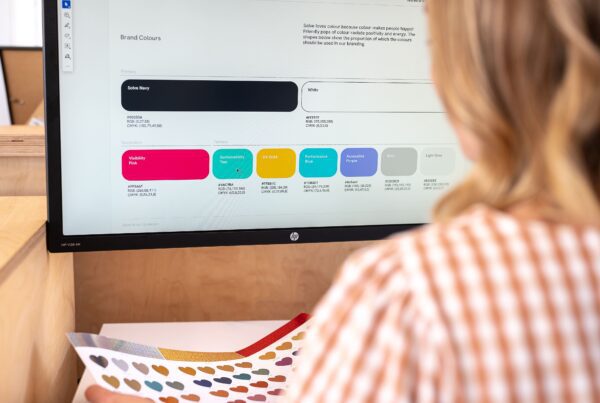
In this blog, we answer the question: What is user experience? Read on to find out what user experience is and how it could boost your business.
Table of Contents
What is User Experience (UX)?
Definition
User experience (also known as UX) refers to the overall experience someone has when using a product, system, or service. The meaning in this instance is the experience of interacting with your website. Good UX is about easy, accessible, effective design that centres the user, helping them achieve their goals.
UX vs UI
UX (User Experience) and UI (User Interface) are closely related, but there are key differences to help you separate them. Think of UX as the overall customer experience from start to finish and everything in between. Covering everything from usability and accessibility to emotional impact. On the other hand, UI refers to design specifics, such as the buttons, colours, fonts, and interactive elements of the site.
Elements of User Experience in Web Design
Usability
At the heart of every successful website is strong usability. Simply put, usability measures how easy it is for visitors to navigate and interact with your site. A truly user-friendly website features a responsive design, intuitive structure, and clear navigation.
To effectively meet the needs of your target audience, it’s essential to keep your site clear, concise, and logically organised, laying the foundation for a seamless and satisfying user experience. If user experience is a pyramid, usability is at the top.

Accessibility
Accessibility is about making sure everyone can enjoy a seamless and inclusive experience on your website, regardless of ability. A truly great website doesn’t just prioritise design and functionality; it also accounts for users with disabilities.
Key accessibility features include descriptive alt text for images, captions for videos, readable font choices, high-contrast colour schemes, and full keyboard navigability. These thoughtful considerations not only broaden your audience but also demonstrate a commitment to inclusivity.
Information Architecture
Think of information architecture as the backbone of the website. It refers to how a website is organised, labelled, and presented. Successful information architecture helps users navigate your site through intuitively categorised content and logical menus that are easy to follow.
If a website has been designed with this in mind, the user’s journey through your website will be quick, easy, and enjoyable, making them more likely to buy or interact with you.
Interaction Design
When a user clicks a button on your website, they expect immediate visual confirmation that their action has been registered. This is interaction design: buttons, forms, links, anything your user could interact with. Effective interaction design provides clear feedback, reduces confusion, and predicts your users’ needs, playing a pivotal role in their overall experience of the site.
Visual Design
Great visual design establishes a hierarchy within your website, prioritising key elements you want to draw attention to. This is done through beautiful typography, careful colour choices, and engaging imagery, working together to make a website visually appealing to your user.
Why User Experience Matters
Improved User Satisfaction
It’s no surprise that in today’s world of modern technology and mobile phones, we’ve grown used to instant responses and immediate results. With just a quick Google search, we can access hundreds of suggestions in seconds. That’s why, if your website delivers a poor user experience, customers won’t hesitate to look elsewhere for the products or services they need. If you want customers to stay, buy, and revisit your website, the user experience must be carefully considered.
Just like visiting a restaurant or a shop, your website’s user experience is a reflection of your customer service. When that experience is excellent, customers are more likely to leave positive reviews and return to your business.
Increased Conversions
User experience has a measurable impact on your website’s ability to turn visitors into buyers. Through streamlined navigation, excellent design, and clear calls to action, your website will offer a frictionless experience, leaving no time for hesitations or second thoughts.

Competitive Advantage
In a crowded digital landscape where service is constantly getting slicker and more rationalised, considered UX helps set your website apart from the competition and gets picked up on by search engines. Investing in UX not only improves your website but also uplifts your brand’s position in the market.
Getting started with UX in Web Design
Investing in Usability Testing
Regular UX testing helps to ensure your website evolves with your users’ needs, identifying pain points and any blockers that could prevent them from getting what they need. Understanding how real people interact with your site through user testing is invaluable information that will help inform the UX design process. Check out how our focus on user experience helps our clients get results.
Completing a UX Audit for Your Website
A UX audit is a comprehensive view of your website’s user experience. Through evaluating usability, accessibility, information architecture and interactive design, you can make informed decisions about where to focus your improvement efforts. Why not book a UX audit for your site so you can start your journey to a positive digital customer experience?
FAQ’s
What is an example of user experience?
A simple example of user experience is someone shopping on an e-commerce website. Their experience includes how easily they can find the product they’re looking for, add it to their basket, and complete the checkout process. Every step along the way shapes how they feel about using the site. Check out Padstow Sealife Safari’s design and layout to discover how Solve has made a logical website that encompasses all the key aspects of a positive user experience.
What defines a good user experience?
While a good user experience can vary from person to person, it typically includes intuitive navigation, a clear structure, and well-organised content. The goal is to help users find what they need quickly and easily, without confusion or frustration. If they leave your website feeling good about the process, they’ve had a positive user experience.
What are UX Skills?
Skills in UX include user research, usability testing, information architecture, interaction design, and visual design. UX professionals also need empathy, problem-solving abilities, and strong communication to advocate for user needs throughout the design process.





